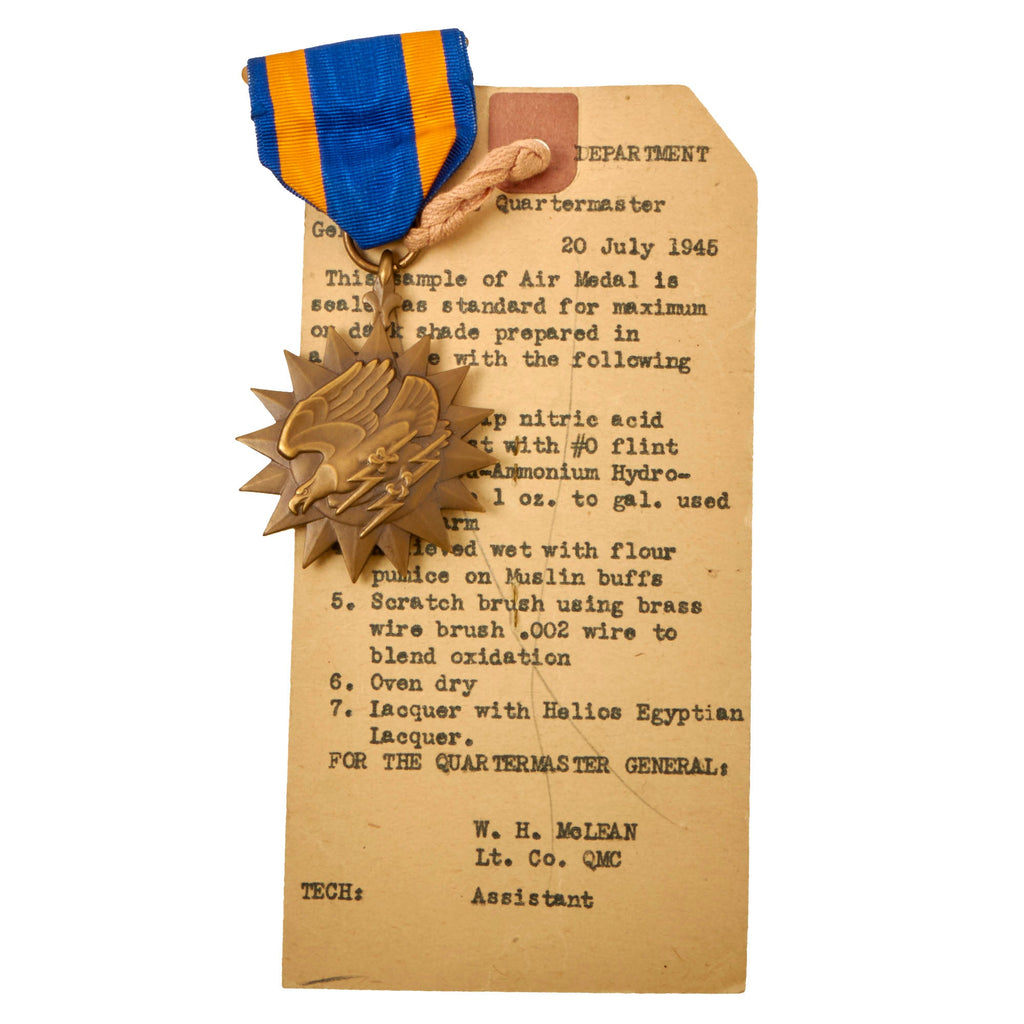Item Description
Original Item: Only One Available. This is an exceptional example of a genuine Quartermaster General “Standard Sample” of the Air Medal. This medal is still attached to the card by the original string which is sealed on the back of the card, showing no breaks meaning this has stayed together since 1945! The Air Medal (AM) is a military decoration of the United States Armed Forces. It was created in 1942 and is awarded for single acts of heroism or meritorious achievement while participating in aerial flight.
The cards reads as follows:
WAR DEPARTMENT
Office of The Quartermaster General 20 July 1945
This sample of Air Medal is sealed as standard for maximum or dark shade prepared in accordance with the following formulas:
1. Bright dip nitric acid
2. Sandblast with #0 flint
3. Oxidized-Ammonium Hydrosulphide 1 oz. to gal. used Lukewarm
4. Relieved wet with flour pumice on Muslin buffs
5. Scratch brush using brass wire brush .002 wire to blend oxidation
6. Oven dry
7. lacquer with Helios Egyptian Lacquer.
FOR THE QUARTERMASTER GENERAL:
W. H. McLEAN
Lt. Co. QMC
TECH: Assistant
Comes more than ready for further research and display.
The Air Medal was established by Executive Order 9158, signed by Franklin D. Roosevelt on May 11, 1942. It was awarded retroactive to September 8, 1939, to anyone who distinguishes himself by meritorious achievement while serving with the Armed Forces in aerial flight.
The original award criteria set by an Army Policy Letter dated September 25, 1942, were for one award of the Air Medal:
per each naval vessel or three enemy aircraft in flight confirmed destroyed. An entire aircrew would be credited for the destruction of a ship, but only the pilot or gunner responsible would be credited for destroying an enemy aircraft.
per 25 operational flights during which exposure to enemy fire is expected.
per 100 operational flights during which exposure to enemy fire is not expected.
These criteria were altered by the commanding generals of each numbered Air Force to fit the conditions of their theater of operations and to maintain morale. The Distinguished Flying Cross would usually be awarded for roughly twice to five times the requirements of the Air Medal. This led to automatic "score card" awards of the Air Medal and Distinguished Flying Cross for completing a set number of operational missions rather than distinguished service, meritorious action, or bravery, as had been intended. On August 5, 1943, such score card awards were officially abolished by a Headquarters Army Air Forces Awards Board memorandum due to the embarrassment when airmen received the Air Medal for "score carding" five missions or more but were later removed from flying duties for "lack of moral fibre". Commanders could still issue the awards on those grounds, but the recipient must perform exceptional or meritorious service as well.
During World War II, the medal's award criteria varied widely depending on the theater of operations, the aircraft flown, and the missions accomplished. In Europe, the airspace was considered completely controlled by the enemy and heavy air defenses were encountered, so the criteria were altered from those of the original medal. Bomber, photographic reconnaissance, or observation crewmembers and air transport pilots received it for five sorties, fighter pilots received it for ten sorties, and individual pilots or air crewmen received one award per enemy aircraft shot down. Elsewhere in the Pacific and the China Burma India Theater, the pilots and crews flew mostly over uncontrolled or contested airspace for long hours and lighter air defenses were encountered, so much higher criteria were used. Anti-submarine patrols from the United States could qualify for the medal if an airman logged 200 hours of flight time.
- This product is available for international shipping.
- Eligible for all payments - Visa, Mastercard, Discover, AMEX, Paypal & Sezzle









